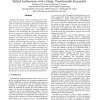Free Online Productivity Tools
i2Speak
i2Symbol
i2OCR
iTex2Img
iWeb2Print
iWeb2Shot
i2Type
iPdf2Split
iPdf2Merge
i2Bopomofo
i2Arabic
i2Style
i2Image
i2PDF
iLatex2Rtf
Sci2ools
FCCM
2003
IEEE
2003
IEEE
Efficient Application Representation for HASTE: Hybrid Architectures with a Single, Transformable Executable
Hybrid architectures, which are composed of a conventional processor closely coupled with reconfigurable logic, seem to combine the advantages of both types of hardware. They present some practical difficulties, however. The interface between the processor and the reconfigurable logic is crucial to performance and is often difficult to implement well. Partitioning the application between the processor and logic is a difficult task, typically complicated by entirely different programming models, heterogeneous interfaces to external resources, and incompatible representations of applications. A separate executable must be produced and maintained for each type of hardware. A novel architecture called HASTE (Hybrid Architecture with a Single Transformable Executable) solves many of these difficulties. HASTE allows a single executable to represent an entire application, including portions that run on a reconfigurable fabric and portions that run on a sequential processor. This executable c...
| Added | 04 Jul 2010 |
| Updated | 04 Jul 2010 |
| Type | Conference |
| Year | 2003 |
| Where | FCCM |
| Authors | Benjamin A. Levine, Herman Schmit |
Comments (0)

